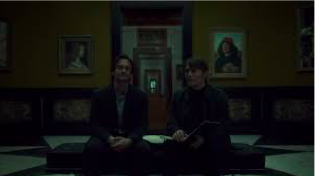Episode 9: “Shiizakana”
Hannibal Lecter: No one can be fully aware of another human being unless we love them. By that love, we see potential in our beloved. Through that love, we allow our beloved to see their potential. Expressing that love, our beloved’s potential comes true. [cf. Frankl]
(general spoiler warning – this article is intended for folks who have seen NBC Hannibal through Season 3 and and/or are curious about the queer symbolism throughout the show, especially in regards to Hannibal Lecter himself)
It’s no secret that NBC Hannibal took source material that was intensely homophobic, misogynist, and transphobic – and created something both racially diverse and miles away from the panicking-naked-women tropes we’re so numbly accustomed to in the horror genre.
It’s difficult for fans of the show to remember a time when queer fans who saw sparks flying between doe-eyed waif Will Graham (Hugh Dancy) and cosmically still Dr. Lecter (Mads Mikkelsen) were shot down by straight fans. “Wishful thinking” they said. “You’re just seeing gay everywhere” they said. Well, it did happen. And not only is this intense relationship now undeniably real, it is also premeditated.
The most fantastic thing in my mind is not the explicit queerness itself – it’s the deeply rooted homage to queer mythological symbols that Hannibal weaves into the story. It’s a whisper directly into the ears of queer people who, as students, would comb their textbooks for evidence that we existed.
Telling Your Loved One About Patroclus and Achilles
Episode 12: “Tome-Wan”
Hannibal Lecter: Achilles, lamenting the death of Patroclus. Whenever he’s mentioned in the Iliad, Patroclus seems to be defined by his empathy.
Will Graham: He became Achilles on the field of war. He died for him there, wearing his armor.
Hannibal Lecter: He did. Hiding and revealing identity is a constant theme throughout the Greek epics.
Will Graham: As are battle-tested friendships.
Hannibal Lecter: Achilles wished all Greeks would die, so that he and Patroclus could conquer Troy alone. Took divine intervention to bring them down.

For those unfamiliar with the illustrious history of queer lore, telling someone about Achilles and Patroclus is, in heterosexual terms, saying that you and your friend are like Romeo and Juliet. Patroclus and Achilles are literally the gay version of Romeo and Juliet – except they definitely had a lot more sex and an established relationship prior to their violent deaths. They are the very symbol of romantic love and companionship so deep, so pure that they die for each other.
Erecting a statue of Saint Sebastian using living symbolic plants
A lot of people have analyzed Hannibal’s murder tableaus as they would analyze art pieces, and this is really fantastic. (for instance, Primavera painting analysis here – http://after-the-ellipsis.tumblr.com/post/124006307094/hello-i-was-hoping-you-could-help-me-understand ) Aside from lavish dinner parties, this is the main way Hannibal expresses himself in a public way – not just artistically, but emotionally. His more conventional artistic pursuits (sketching, harpsichord, etc) seem to be more private enjoyments.
The homoerotic symbolism of Saint Sebastian has been written about extensively, so there is no need for me to repeat myself too much here. http://www.independent.co.uk/arts-entertainment/art/features/arrows-of-desire-how-did-st-sebastian-become-an-enduring-homo-erotic-icon-779388.html

This is just one among many pieces that Hannibal leaves for Will’s enjoyment like so many savaged mice left on your doorstep by your naughty outdoor cat.
A Tightly Folded Valentine’s Heart made from a queer man’s body
Hannibal folds a paper with the image of the vitruvian man – a symbol of the beauty of the male body, and a worshipful image for any classically trained visual artist such as Hannibal. In folding it, he is also twisting and dismembering it. Since the vitruvian man also happens to have the scruffy waif look down, this is a nice image of Hannibal’s emotional synesthesia when it comes to love, destruction, and consumption. It’s also a beautiful foreshadowing to the next lurching horror/art instillation…

The heart mounted on three swords is the ultimate dead-mouse-on-the-doorstep for Hannibal. It’s a valentine – literally, a folded heart made from the body of a queer man, presented in the most worshipful way possible – and right where Will can see it.
But it’s not just a Valentine’s day card. It’s also the Three of Swords Reversed.

The three of swords in Tarot symbology came to look like the image above, thanks to the queer artist who painted the Rider Waite deck, Pamela Colman Smith. Another piece of queer history neatly given respect in this series.
The Three of Swords symbolizes loss, heartbreak, and betrayal. By reversing it, Hannibal is asking if that betrayal, that loss, that heartbreak can be overcome.
Episode 3: “Secondo”
Bedelia Du Maurier: Forgiveness is too great and difficult for one person. It requires two. A betrayer and a betrayed. Which one are you?
Hannibal Lecter: I’m vague on those details.
Bedelia Du Maurier: Betrayal and forgiveness are best seen as something akin to falling in love.
Hannibal Lecter: You cannot control with respect to whom you fall in love.
Episode 6: “Dolce”
Hannibal Lecter: Now is the hardest test: not letting rage and frustration… nor forgiveness keep you from thinking. Shall we?
Will Graham: After you. [cf. Wilde: Always forgive your enemies; nothing annoys them so much.]
Plato’s Origin Of Love
In the Series 3 episode Dolce, there is a quiet scene between Hannibal and Will in the Uffizi Gallery. Both characters have suffered some scrapes and have been apart for quite a while. But the placement of their facial injuries was a symbolic calculation. To the outside, they look relatively clean.

But as the camera moves closer, and comes to their own points of view – we see their intentionally asymmetric facial injuries.

Their faces are broken and torn on the sides which face each other – as though they were once connected, then severed apart. It can’t help but bring to mind conjoined births – two-faced gods – and of course, the once-joined, violently severed lovers of Aristophanes (and much later, of Hedwig).

Just as Hannibal is not simply a police procedural, and not simply a re-telling of a series of novels – it is also not simply a gay romance. There is no effort to make same sex love “just like everyone else”, whether it be between Will and Hannibal or resident surviving women Alana Bloom and Margot Verger. It is about love on an epic, unreal, mythological level. It is about self expression, worship, and empathy. It is about trauma and wounds and creation and survival. It is poetry.
Episode 12: “The Number of the Beast is 666…”
Will Graham: Is Hannibal in love with me?
Bedelia Du Maurier: Could he daily feel a stab of hunger for you, and find nourishment at the very sight of you? Yes. But do you ache for him?








0 Comments